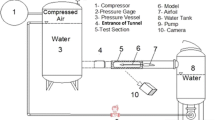Abstract
The mathematical model is developed for the submerged cavatation jet flow. The mathematical model, which is utilized to describe filed flow, is k-ε turbulent model. Vapor volume fraction f is obtained by vapor transport equation. Nozzles of cavitation jet flow are designed for the carrying out of experimental study. Simulation of fluid flow for cavitation jet flow is carried out to obtain velocity, pressure and vapor volume fraction. The cavitation phenomenon is proven very obvious for angular nozzle. The cavitation experiments are conducted to show the cavitation phenomena.
Access this chapter
Tax calculation will be finalised at checkout
Purchases are for personal use only
Preview
Unable to display preview. Download preview PDF.
Similar content being viewed by others
References
Uhlman, J.S.: The surface singularity method applied to partially cavitating hydrofoils. J. Ship Res., 107–124 (1987)
Doctors, L.J.: Effects of a finite Froude number on a supercavitating hydrofoil. J. Ship Res., 1–11 (1998)
Delannoy, Y.: Modelisation d’ecoulements instationnaires et cavitants. Thesis. Institut National Polytechnique de Grenoble (1989)
Kinnas, S.A., Fine, N.E.: A numerical non-linear analysis of the flow around two and three dimensional partially cavitating hydrofoils. J. Fluid Mech., 151–181 (1993)
Chen, Y., Heister, S.: Two-phase modeling of cavitating flows. Computers and Fluids 24(7), 799–809 (1995)
Kubota, A., Kato, H., Yamaguchi, H.: A new modeling of cavitating flows: a numerical study of unsteady cavitation on a hydrofoil section. J. Fluid Mech., 59–96 (1992)
Singhal, A.K., Li, H., Athavale, M.M., Jiang, Y.: Mathematical basis and validation of the full cavitation model// ASME Paper FEDSM2001- 18015. In: Proc. of 2001 ASME Fluids Engineering Division Summer Meeting, New Orleans, Louisiana (2001)
Kunz, R.F., Lindau, J.W., Billet, M.L., Stinebring, D.: Multiphase CFD modeling of developed and supercavitating flows. RTO-EN-010, No.13,RTO (The Research and Technology Organization of NATO) AVT Lecture Series on “Supercavitating Flows”, Brussels, Belgium (2001)
Xue-sen, C., Zhi, W., Kai, Y.: Parametric study on numerical simulation of natural cavitation flow. Journal of Ship Mechanics 11(1), 32–39 (2007)
Author information
Authors and Affiliations
Editor information
Editors and Affiliations
Rights and permissions
Copyright information
© 2009 Springer-Verlag Berlin Heidelberg
About this paper
Cite this paper
Deng, Ss., Li, Zj., Zhang, Fl., Si, Yg., Feng, J., Chen, Gm. (2009). Numerical Simulation and Experimental Study of Cavitation Jet Flow. In: Cao, B., Li, TF., Zhang, CY. (eds) Fuzzy Information and Engineering Volume 2. Advances in Intelligent and Soft Computing, vol 62. Springer, Berlin, Heidelberg. https://doi.org/10.1007/978-3-642-03664-4_98
Download citation
DOI: https://doi.org/10.1007/978-3-642-03664-4_98
Publisher Name: Springer, Berlin, Heidelberg
Print ISBN: 978-3-642-03663-7
Online ISBN: 978-3-642-03664-4
eBook Packages: EngineeringEngineering (R0)




